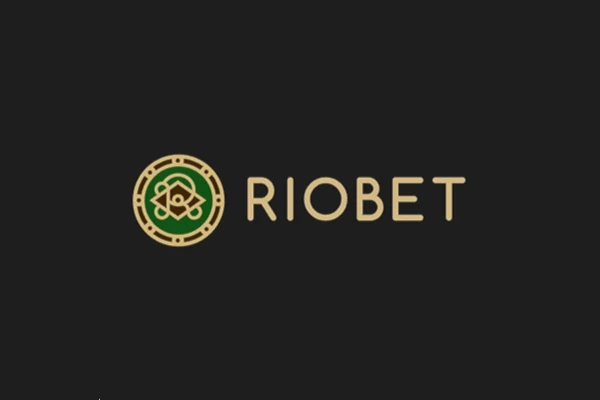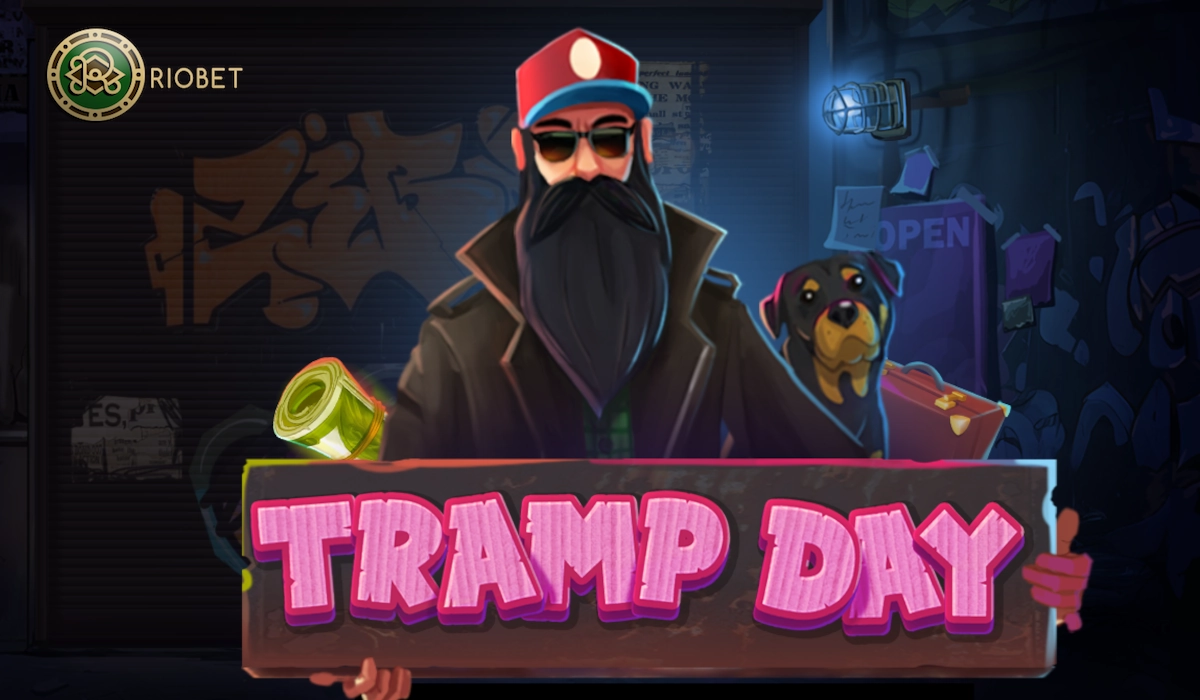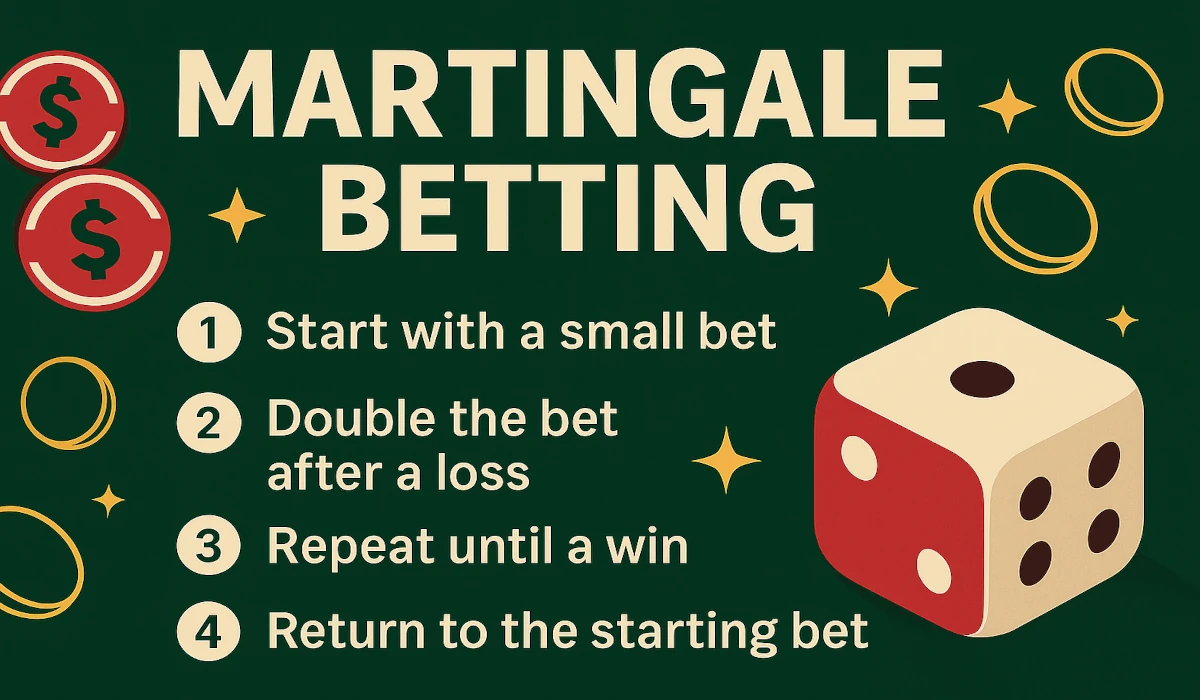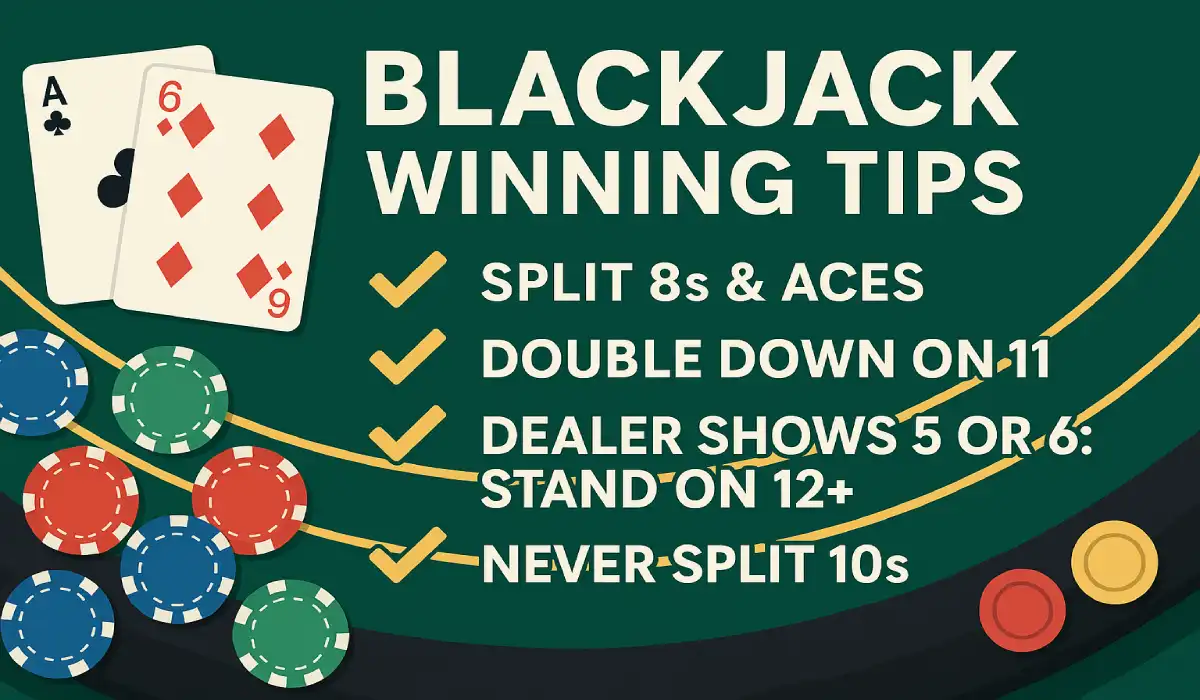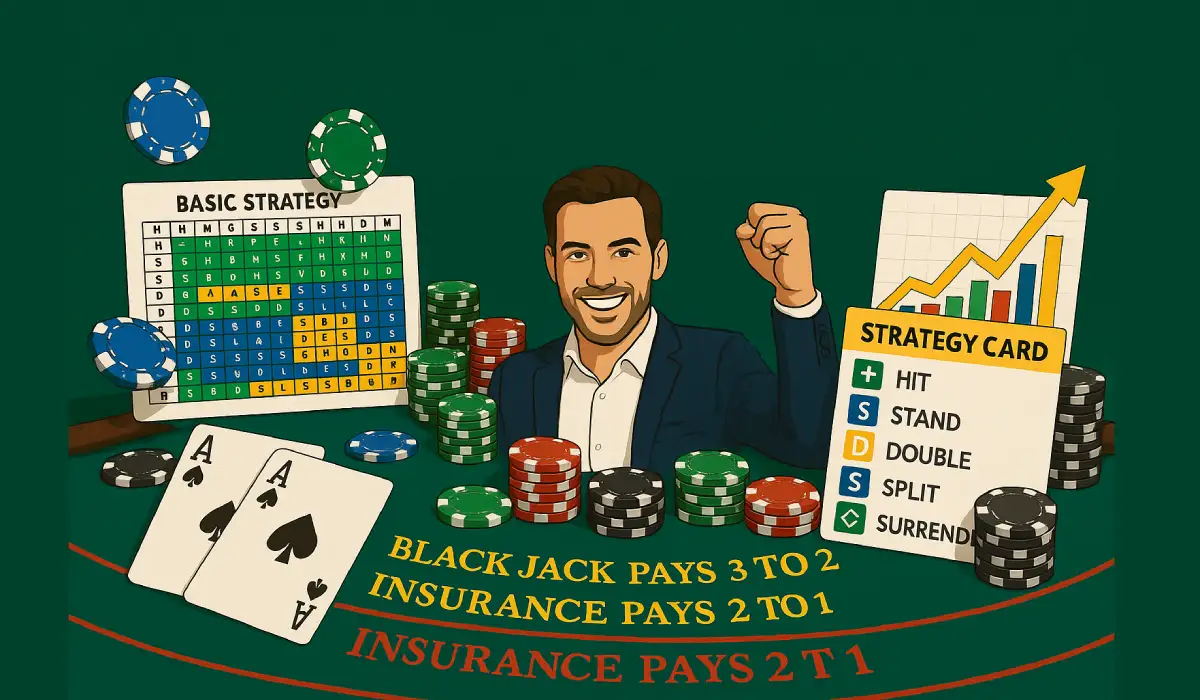
07 Jul 2025
Mastering Double Deck Blackjack Strategy: Tips for Winning
🗝️ Key Takeaways
- Double deck blackjack is a step ahead of single and multi-deck games in terms of house edge and card tracking, which has made it popular with both new and experienced players globally.
- Strategic play is aided by the lower deck count, as it renders card counting and systems such as Hi-Lo more easy and effective for players who know the math and law.
- If you master the basics — how to play hard and soft hands strategically, splitting pairs at the right time, doubling down with discipline, and knowing when to surrender — you can maximize your chances of success in double deck blackjack.
- Adjusting to key rule variations, such as dealer peeks, doubling rules, and splitting aces, helps reduce risk and optimize return. Players should always check table-specific rules before sitting down.
- Sophisticated counting methods — such as precise, accurate count adjustments and optimized bet spreads — can still deliver a quantifiable advantage with disciplined execution and customization to the double deck setup.
- Steering clear of common mistakes, such as bad bankroll management, reckless insurance bets, and needless basic strategy deviations, is important for the long haul. Consistently applying disciplined, informed decision-making will still maximize your long-run outcome.
Double deck blackjack strategy refers to the moves and decisions that optimize players’ value in a double deck game. The odds and card count change a little in double deck blackjack compared to the traditional six or eight deck games.
That’s the reason small changes in gameplay tactics can determine whether there is a gain or a deficit. Hitting, standing, or splitting follows rules based upon what cards show on the table. A lot of players care about house edge and want to play smart with every hand.
To illustrate how these strategies function, the following sections will break down essential strategy elements and provide advice for both novice and experienced blackjack enthusiasts.
🃏 The Double Deck Advantage
Double deck blackjack is the perfect compromise. It fills the void between single deck games and the popular six or eight deck shoe games, serving as a convenient option for the beginner and seasoned pro alike.
The table below outlines the key advantages of double deck blackjack compared to other variants:
| Feature | Single Deck | Double Deck | Six+ Decks |
| Number of Cards | 52 | 104 | 312–416 |
| Typical House Edge (basic) | 0.15% | 0.2% | 0.5%+ |
| Card Counting Ease | High | Moderate | Low |
| Rule Flexibility | Low | High | Moderate |
| Deck Penetration | 50–70% | 60–75% | 60–80% |
| Card Impact per Removal | Strong | Moderate | Weak |
🎲 Fewer Decks
Fewer decks reduce card randomness, so players can see patterns and exploit them. This allows a player to remember better which cards remain in the deck, enhancing card hand tracking.
Double deck blackjack, with 104 cards, makes every card removal count harder than in multi-deck games.
- Easier tracking of played and remaining cards.
- Increased accuracy in estimating probabilities.
- Less dilution of high and low cards, aiding tallying techniques.
- Simpler for new players to learn and follow.
- Lower bet spread needed for strategic play.
- Faster adaptation for changing game conditions.
This straightforwardness is attractive to rookie players. It provides veteran players a distinct advantage because they can implement more sophisticated techniques with less randomness.
📊 House Edge
Double deck blackjack has a house edge, with basic blackjack strategy, as low as 0.2%. Six or eight deck games usually go from 0.5% or up, and single deck games can be a little bit better, but often with worse rules.
Because the house edge translates into how much you will win or lose in the long term, double deck games are more player-friendly.
- Deck count: Fewer decks lower the edge, boosting player odds.
- Rule variations: Dealer stands on soft 17, doubling after split, late surrender, and resplitting aces all shift the edge in the player's favor.
- Penetration: Deeper penetration (60–75%) allows for better prediction and strategic adjustment.
- Insurance: The edge on insurance is much higher (about 2.8%), so players should avoid it.
Picking games with rules like 3:2 blackjack payouts and dealer stands on soft 17 is key to keeping the house edge as low as possible.
🧮 Card Counting
Double deck blackjack magnifies the power of which is considerably less effective in multi-deck games. With only 104 cards in play, each played card alters the deck in ways that players can monitor.
Tools such as the Hi-Lo system become more dependable, assisting players in increasing their betting when the count is to their advantage.
Because it’s easier to keep a correct running count, errors are less common. This can transform a practiced counter into a true advantage player.
The game’s deeper penetration—shuffling after 60–75% of the cards—lets more rounds occur before the reset, providing counters more opportunities to exercise their skill.
Card counting is not illegal, although blackjack table staff may ban or restrict counters. Ethical play is about understanding the dangers and honoring ground rules.
🎯 Core Double Deck Blackjack Strategy
Double deck blackjack adds a sharper edge. Card removal has a larger impact, therefore every decision carries more weight. Becoming a pro at the core strategy involves understanding how to play hard and soft hands, when to split pairs, double down, and surrender.
Less cards = count swings fast, so it’s important to track what’s left in the shoe. Favor games with deep penetration—over 65% of cards dealt before shuffling—and rules like 3:2 blackjack payouts, dealer stands on soft 17, and doubling after split.
1. Hard Hands
A hard hand is any hand that contains no Ace counted as 11. Double deck, hit 8 or less, always.
With 9, if the dealer has 3–6, double, else hit. For 10 and 11, double if the dealer has 2–9 (for 10) or 2–10 (for 11), but just hit if they have a dealer Ace.
If 12, hit a 2 or 3, stand on 4–6, and hit a 7 or higher. Standing 13–16 vs 2–6, but hit otherwise, is crucial.
Misplays include standing 12 vs. Dealer 2 and hitting 16 vs. Dealer 6 – both errors in this iteration. It’s these specific details that help you avoid the usual pitfalls.
2. Soft Hands
Soft hands have an Ace that’s counted as 11. They provide greater scope.
With Ace-2 to Ace-7, double if the dealer shows 5 or 6, otherwise hit. A-8 and A-9 stand, except double A-8 v dealer 6.
Soft hands give you more flexibility, particularly because you can’t bust on the next card. Doubling is powerful here: Ace-6 versus dealer 3–6, double; others, just hit.
These moves provide you more opportunities to win a side bet or take advantage of a vulnerable dealer Ace.
3. Pair Splitting
Split Aces and eights, regardless of what the dealer has. Never split tens, fives or fours – tens make a very strong 20, and fives are better played as ten.
Split 2’s and 3’s vs. A dealer 4–7. Fours only split when permitted to DAS, and the dealer has a 5 or 6.
Split sixes versus 2–6, sevens against 2–7, nines against 2–6 and 8–9, adjusting for dealer’s upcard. Each split alters your card hand composition, so be aware of when it benefits or harms you.
4. Doubling Down
Double 10 vs. Dealer 2–9, 11 vs. 2–10. If the Reno Rule applies, double more often, like with soft hands.
Never double against a dealer Ace or ten. Doubling provides the biggest bang when the dealer is most vulnerable, but will cost you more if abused.
Understand your card hand and the dealer’s upcard before you raise the betting amount.
5. Surrender Plays
Surrender 16 vs. 9, 10 or A, and 15 vs. 10. Late surrender is the most common, early surrender is more rare and better.
Surrender slices losses from crap hands and preserves your bankroll for more favorable situations. Make it part of your basic strategy chart.
💥 Critical Rule Variations
Double deck blackjack has its own blackjack table rules, and these nuances can tip the house edge one way or another against the player. These are the most important rule variations, and if you get them, you can shape a sound strategy.
Here is a table of some common rule variations and their effect on the house edge.
| Rule Variation | House Edge Impact | Example/Effect |
| Dealer hits on soft 17 (H17) | +0.20% | More losses for players |
| Dealer stands on soft 17 (S17) | -0.20% | Better odds for players |
| Doubling after split (DAS) allowed | -0.14% | More flexibility, lower house edge |
| Re-splitting aces allowed | -0.08% | Increases player’s winning chances |
| Late surrender allowed | -0.08% | Lets players save bets on bad hands |
| Blackjack pays 6:5 (not 3:2) | +1.40% | Bad for players, avoid these tables |
⚡ Dealer Actions
The dealer’s deeds dictate nearly every hand. Most double deck games have the dealer hit or stand on soft 17 (Ace and 6).
If the dealer draws on a soft 17, the house advantage grows by approximately 0.2%. If the dealer stands, that edge falls, making players’ chances a little more favorable.
That little variation allows players to tweak their basic blackjack strategy, such as doubling down more frequently on soft hands when the dealer hits soft 17. Understanding what the dealer needs to do helps you make crisper calls.
With dealer hits on soft 17, double soft 14 versus a dealer 4, and soft 18 versus a dealer 2. These playing tweaks can help you stay ahead as the table turns.
🚀 Doubling Rules
They are not all laid out with the same double down options. A few permit doubling after a split (DAS), which reduces the house advantage by 0.14%.
Some don’t, which restricts your alternatives and can reduce your profits. Critical times to double come when the dealer has a weak card, like a 4, 5, or 6, but verify the table rules because not every joint allows you to double after splitting a pair of 5’s.
A loose doubling rule allows you to double your advantage when the dealer is vulnerable, but rigid rules make you hesitate. Always skim the rules first.
Certain tables prohibit doubling on anything but 2-card hands. This reduces strategic play, so adjust your technique and stay away from doubling where it’s prohibited.
✨ Splitting Aces
Splitting aces provides you with an opportunity to create two very strong hands, but not every game allows you to resplit or even hit again after splitting aces. When you can resplit, the house edge decreases by approximately 0.08%, which is a genuine benefit.
Without it, you only receive one card on each split ace, so your chances fall. If the dealer’s upcard is a 7 or lower, splitting aces is just about always correct—but be aware of your blackjack table rules.
If you can’t resplit or double after a split, you lose critical advantages. Always split aces when you can, but if the rules are stiff, be prepared to pivot.
🌟 Advanced Card Counting
Double deck blackjack provides players a genuine opportunity to beat the house. With only two decks, every card that hits the tables from the shoe shifts the odds more than in multi-deck games.
Advanced card counting raises this to an entirely new level, allowing savvy players to reduce the house edge to below 0.5% or even swing it in their favor.
✅ System Viability
A lot of players begin with systems such as KO (Knock-Out), which is unbalanced and super easy to track, if negatives are difficult. Others seeking additional precision opt for level 2 systems such as HO2 (Halves or Hi-Opt II), which track additional card values but require more expertise and training.
Each system involves tradeoffs. KO is fast and works for most, but HO2 can provide more precise indications on when to deviate, particularly around splits and doubles.
Try both in practice games to see which one feels right. Unbalanced systems require a pivot point and balanced systems require true count conversion.
Keep current—new tweaks and strategies are posted in forums and by pros constantly.
🎲 True Count
True count is key in double deck games. To locate it, divide your running count by the decks remaining.
For instance, if your running count is +4 and there’s one deck remaining, the true count is +4. If two decks remain, it’s +2. That’s important because each card carries more weight with less decks.
Running count by itself is deceptive in double deck games, so make sure to convert to true count to see the whole story. An accurate true count informs you when to increase bets, shift strategies, or even walk away.
Maintaining a precise count throughout the game is crucial – one mistake, and your advantage disappears.
🔍 Bet Spreads
A good bet spread helps you maximize your edge. When the true count is elevated, increase your wager.
When it falls, decrease your bet or even take a seat. Don’t overdo it—huge spreads like 1:300 stand out and can get you barred.
Try moderate spreads, like 1:6 or 1:8, to stay under the radar. Follow your bankroll carefully. Raise your bet only when you have the advantage and the count is positive.
❌ Common Player Missteps
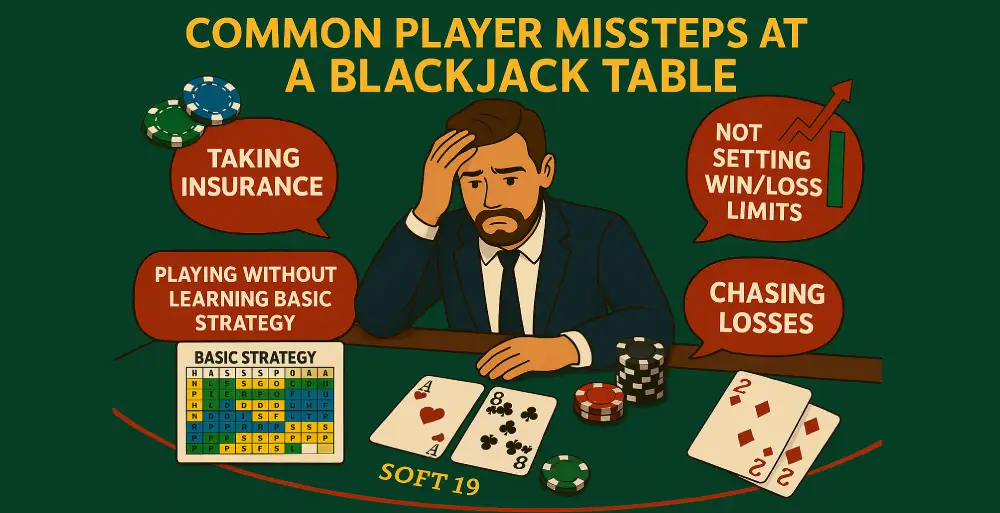
Yet even in double deck blackjack, competent players can slip into detrimental routines. Tiny errors pile up, and bigger losses result.
Identifying these sins and correcting them is crucial to top play and extended bankroll life.
- Hits on 18 are usually a blunder, particularly if it’s a soft one. This hand is much weaker than people realize.
- Failing to split 8s or Aces when the time is right. Splitting 5s or 10s is a classic player blunder.
- To hit, instead of doubling down, soft hands – like a soft 18 vs dealer 2-6 – is value bleeding for players.
- Doubling down too much or not enough, resulting in bigger losses.
- Failing to split 8s versus a dealer’s 7, instead of hitting, is a pricey blunder.
- Putting down 16 against a dealer’s 7, when you should hit and go for a stronger hand.
- Not changing your play according to the dealer’s upcard, e.g., missing that the dealer’s 3, 4, 5, or 6 is more likely to bust.
- The dealer’s 10 is a hard area, and a lot of players stumble here.
- Common player mistake #1: Blowing off basic strategy because of a hot gut or a streak.
🛡️ Insurance Bets
Insurance bets confuse a lot of double deck blackjack players. These are side bets that come into play when the dealer displays an Ace, alluring the players with the opportunity to insure their hand.
- Your chances of hitting insurance hardly ever makes it worth the risk. Almost always, the dealer doesn’t have blackjack, and insurance pays less in the long run.
- Taking insurance on “hunches” results in a nice little bankroll hemorrhage. It’s great only when the player has a count advantage, which, as you already know, is uncommon without sophisticated counting.
- Insurance ought to factor into the strategy only for card counters. Otherwise, it’s a sucker’s bet and best to steer clear.
⚖️ Strategy Deviations
Straying from basic strategy occasionally pays off, but only in sparse, specific circumstances. For the vast majority, staying with the chart is the best approach.
Some advanced players make some concessions to deck composition, like hitting on 16 vs. A dealer’s 10 when there are more small cards left. The stakes are high if assumptions are incorrect.
As usual, the safest route for most is to abide by fundamental strategy and then deviate only after serious research and experimentation. Knowing when to make adjustments is the key. Most should concentrate on nailing down fundamental moves before attempting to get fancy.
🚫 Bankroll Neglect
Many of them get into trouble due to poor bankroll management. Putting hard loss and win limits in place is essential to make it through streaks.
Following your bets keeps you out of the chasing loss’s trap. This discipline manages your session and extends your play.
It’s so effortless to succumb to emotion at the table. The most successful players are the ones who maintain a cool head and remain disciplined.
💡 Beyond The Basic Chart
Double deck blackjack is a game of nuance, where subtle shifts in card distribution and table conditions influence player decisions. Basic strategy charts might be the foundation, but it is the advanced strategies that elevate those sky-high win rates.
To be clear, mastering these techniques necessitates diligent tracking of deck composition, comprehension of shuffling consequences, and tactical decisions at the table.
♠️ Composition Plays
Not every hand with the same total is equally powerful. If you have a 10-6 vs a dealer 10, your decision to hit or stand changes if the deck is high in small cards.
Keeping tabs on what cards have exited the deck allows you to adjust—splitting 10s is generally a no-no, but in a positive count (+2 or better), splitting 10s vs dealer 5 or 6 is best. Composition-dependent strategy, though central to single-deck games, remains salient in double deck with some adjustments.
Splitting and doubling strategies as the deck thins can a real edge.
Players who add card counting and composition plays to their arsenal can make those bets even more acutely. For instance, when to surrender 16 vs dealer 9-A in the correct count, or double soft 18 vs 2-6, is more than basic chart knowledge.
These next-level maneuvers demand mastery of the existing deck and rapid acclimation.
🎲 Shuffling Impact
The dealer’s shuffle determines how clumpy or spread out cards are, which influences card counting. In double deck, with only 104 cards, small variations in shuffling can tip the odds.
Some casinos employ hand shuffles, others machines, and each style alters card flow. Knowing this, experienced players might count clumps of cards or factor in shuffle strength.
Shuffle tracking is an advanced technique. Though difficult to perfect, even seeing shifts in card count can tell you when to turn up the wager. If a shuffle bunches more high cards together, however, then aggressive betting can pay dividends.
Adjusting to constant or random shuffles is crucial for any competitive player.
🎰 Table Selection
Selecting an appropriate double deck table counts. Find good rules tables—look for dealers who stand on soft 17, late surrender, and double after splits.
No tables with bad conditions or limited deck penetration. Evaluate the ability of your opponents.
A busy table with experienced counters can wear down your advantage, but a rookie table might provide more chances to shine. Table choice is another factor overlooked by the average player.
Informed table selection, based on rules and player skill, can increase your long-term results.
🔒 Conclusion
To conquer double deck blackjack, stay on point with your moves. Learn the basic chart.
Pay attention to the dealer rules. Pay attention to the shoe size on each shuffle.
Little rule or deck shifts can tip the odds. Well, count cards if the casino allows.
Ditch gut calls in sticky situations. Stick to it.
Take lessons from every hand, even those you lose. The double deck game rewards concentration and toughness.
Players who ditch old habits and train new skills see little victories accumulate. To gain experience, exchange advice and experiment with what works out at actual tables.
Frequently Asked Questions❓
What is double deck blackjack?
Double deck blackjack is a popular casino card game played with two standard 52-card decks. The game’s rules are similar to standard blackjack, but the reduced deck number alters the probabilities, frequently providing savvy players a greater opportunity to leverage game plan.
How does basic strategy change in double deck blackjack?
Basic strategy double deck blackjack is a bit different than the multiple deck games. For instance, you can double or split in more cases. Fewer decks, the more card counting and choices count.
Why are rule variations important in double deck blackjack?
Rule variations — like if the dealer hits or stands on soft 17 — can have a huge effect on your chances. Be sure to always check the game rules before you play, because minor changes may adjust the house edge toward the casino or the player.
Is card counting easier in double deck blackjack?
For sure, it’s easier to count with less decks. That’s because in double deck blackjack, players can track cards without much difficulty, which — if you do it right and keep it under wraps — can give you a little edge.
What are common mistakes in double deck blackjack?
Typical errors are skipping a basic strategy chart, misinterpreting rule variations, or playing on emotion. Following a tried and true plan and knowing when to split, stand, double down and so forth prevents costly mistakes.
Should I always use the same strategy chart for double deck and multi-deck blackjack?
No, they are different for double deck and multi-deck blackjack. For best decisions, consult a specialized strategy chart for double deck games.
Can double deck blackjack offer better odds to players?
You bet, double deck blackjack can have better odds than multi-deck, particularly when player friendly rules are involved. Adopting the right strategy increases your odds of winning.
